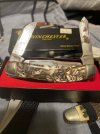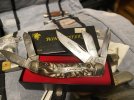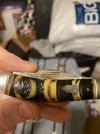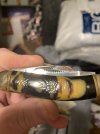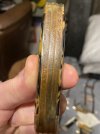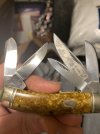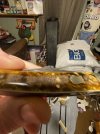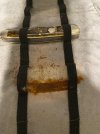You've even got to be careful with materials being used on today's knives. One such is POM and called Cracked Ice by some manufactures. Here's a little tid-bit on POM.
"Polyoxymethylene (POM), also known as acetal,[2] polyacetal, and polyformaldehyde, is an engineering thermoplastic used in precision parts requiring high stiffness, low friction, and excellent dimensional stability. As with many other synthetic polymers, it is produced by different chemical firms with slightly different formulas and sold variously by such names as Delrin, Celcon, Ramtal, Duracon, Kepital, and Hostaform.
POM is characterized by its high strength, hardness and rigidity to −40 °C. POM is intrinsically opaque white, due to its high crystalline composition, but it is available in all colors. POM has a density of 1.410–1.420 g/cm3.[3]
Typical applications for injection-molded POM include high-performance engineering components such as small gear wheels, eyeglass frames, ball bearings, ski bindings, fasteners, guns, knife handles, and lock systems. The material is widely used in the automotive and consumer electronics industry.
DEGRADATION: Acetal resins are sensitive to acid hydrolysis and oxidation by agents such as mineral acids and chlorine. POM homopolymer is also susceptible to alkaline attack and is more susceptible to degradation in hot water. Thus low levels of chlorine in potable water supplies (1–3 ppm) can be sufficient to cause environmental stress cracking, a problem experienced in both the USA and Europe in domestic and commercial water supply systems. Defective mouldings are most sensitive to cracking, but normal mouldings can succumb if the water is hot. Both POM homopolymer and copolymer are stabilized to mitigate these types of degradation.
In addition, POM can have undesirable characteristics when burned. The flame is not self-extinguishing, shows little to no smoke, and the blue flame can be almost invisible in ambient light. Burning also releases formaldehyde gas, which irritates nose, throat, and eye tissues."


